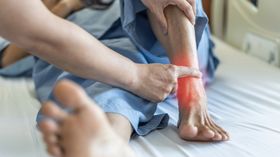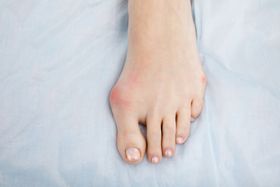Ankle Pain When Walking: Most Common Causes
Updated December 9, 2024.

The source of your ankle pain is often difficult to diagnose due to the complexity of the structures in the area. Ankle pain can arise for many reasons from any of the structures comprising the ankle joint, including the structures in the lower leg and foot. Ankle pain can develop even without injury to the joint. Determining the reason you are experiencing ankle pain is important to understand how to manage it and prevent the pain from reoccurring in the future.
Injury-Related Causes of Ankle Pain When Walking
Injury to the structures making up the ankle complex can lead to the development of pain while walking. Injury is usually due to high compressive or tensile forces applied to the area during activity and can lead to the development of acute ankle pain. Acute ankle pain can progress into chronic ankle pain if the causative factors are not managed adequately or sufficiently.
A twisting or outward roll of the ankle is the most common form of ankle injury reported by people globally. The outward roll of the ankle stretches the ligaments of the outer edge of the joint complex suddenly and may cause damage to the ligament. Pain on the outer edge of the ankle is commonly reported. The tear created by the injury is graded in various stages according to the severity of the injury and symptoms.
Non-Injury-Related Causes of Ankle Pain When Walking
- Osteoarthritis The cartilage lining the joints of the body becomes degraded or worn away leading to the development of pain, usually progressing as a person ages. Injury or surgery to a joint may increase the risk of developing osteoarthritis in the joint in the future.
- Rheumatoid arthritis This is an autoimmune condition in which the body breaks down the cartilage lining the joints of the body through an uncontrolled immune response. Inflammation and pain arise in the affected joint and in other joints in the body. General fatigue, muscle weakness, joint tenderness, and skin redness are all notable symptoms of rheumatoid arthritis.
- Achilles tendonitis Achilles tendonitis is a condition characterized by pain and tenderness around the area of the heel and the Achilles tendon, usually due to injury.
- Flat feet Flat feet are a condition where the arches of the feet do not develop and the majority of the foot makes contact with the floor. Without an arch, the shock applied to the foot while running or jumping is not absorbed sufficiently and increased load is applied to the ankle joint. This increased load can lead to the development of pain in the ankle and other areas of the body. Insoles can be used to prevent pronation of the foot and ankle, thus limiting the potential ankle injuries from occurring.
Preventing Ankle Pain When Walking
The correct footwear and orthotics can aid in preventing pain arising in the ankle joint by reducing the shock load while walking or running. Orthotics can manage other conditions of the foot that could cause pain to arise, such as plantar fasciitis and bunions. Orthotics can also treat overpronated ankles or flat feet effectively.
Resting the ankle from daily activity and strenuous exercise can help you in managing the symptoms that have arisen and will allow time for the inflammation to reduce. Applying ice to the area can also relieve inflammation and bruising around the area and may allow you to return to walking without pain faster. Depending on the grade of the injury, the doctor might suggest not putting weight on your ankle while the initial injury subsides and the structures repair. The doctor may also suggest a foam cast or boot to support the ankle during daily activities, allowing the structures to heal and repair themselves.
Massaging the muscles of the lower leg and the sole of the foot should help relieve tension in any tissue that could be contributing to your pain. Medication to effectively manage conditions such as rheumatoid arthritis can slow down the rate of progression of joint deformity and erosion in the joints.
Exercise to strengthen the muscles of the foot, lower leg, and core of the body can help maintain the correct biomechanical alignment in the body. Through ensuring that the muscles are able to sufficiently cope with the physical requirements of the body, there is a reduced chance of pain or an injury developing. Maintaining a healthy weight can contribute greatly to the health and longevity of your ankles.
You should consult with a medical professional if you are unable to walk two days after an ankle injury or if there is excessive swelling or bruising in the area. High grade impacts to the ankle with blunt objects and adverse symptoms should be assessed and managed by a medical professional.








